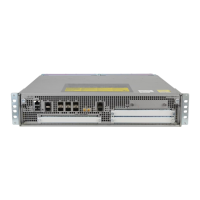Implementing Multicast Routing on Cisco IOS XR Software Cisco ASR 9000 Series Routers
Information About Implementing Multicast Routing
MCC-16
Multicast Configuration Guide
OL-
Unicast extranet can be achieved simply by configuring matching route targets across VRFs. However,
multicast extranet requires such configuration to resolve route lookups across VRFs in addition to the
following:
• Maintain multicast topology maps across VRFs.
• Maintain multicast distribution trees to forward traffic across VRFs.
Information About Extranets
An extranet can be viewed as part of an enterprise intranet that is extended to users outside the enterprise.
A VPN is used as a way to do business with other enterprises and with customers, such as selling
products and maintaining strong business partnerships. An extranet is a VPN that connects to one or
more corporate sites to external business partners or suppliers to securely share a designated part of the
enterprise’s business information or operations.
MVPN extranet routing can be used to solve such business problems as:
• Inefficient content distribution between enterprises.
• Inefficient content distribution from service providers or content providers to their enterprise VPN
customers.
MVPN extranet routing provides support for IPv4 over IPv4 address family solely on the
Cisco
XR 12000 Series Router platform.
An extranet network requires the PE routers to pass traffic across VRFs (labeled “P” in Figure 6).
Extranet networks can run either IPv4 or IPv6 (Cisco IOS XR software currently supports only IPv4),
but the core network always runs only IPv4 native multicast.
Extranet Components
Figure 6 illustrates the components comprising an extranet MVPN.
Figure 6 Components of an Extranet MVPN
MVRF—Multicast VPN routing and forwarding (VRF) instance. An MVRF is a multicast-enabled VRF.
A VRF consists of an IP routing table, a derived forwarding table, a set of interfaces that use the
forwarding table, and a set of rules and routing protocols that determine what goes into the forwarding
table. In general, a VRF includes the routing information that defines a customer VPN site that is
attached to a provider edge (PE) router.
VPN-A
VPN-A
VPN-B
Source
Receiver
Receiver
281304
PE1
CE
CE
CE
P
PE3
PE2
MVRF for VPN-A
Source MVRF
PE1 => Source PE
MVRF for VPN-B
Source MVRF
PE1 => Source PE
MVRF for VPN-A

